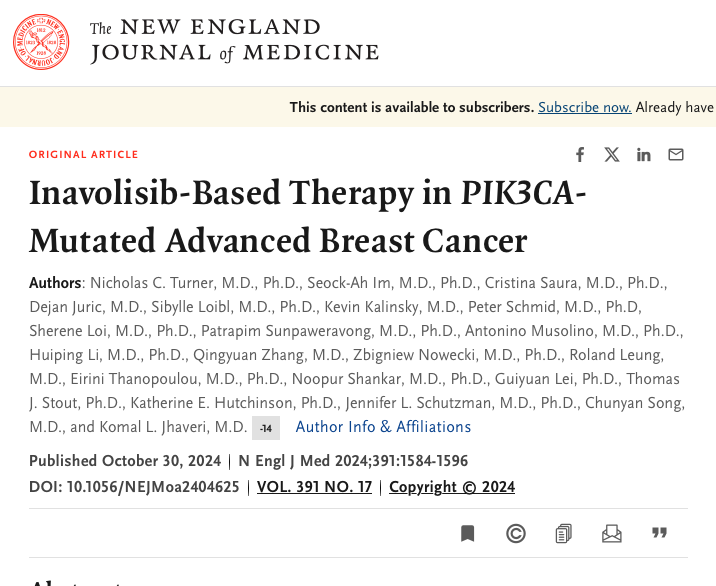
Adding Inavolisib to Fulvestrant and Palbociclib in first line for patients with PIK3CA-Mutation
Komal Jhaveri, Associate Member at Memorial Sloan Kettering Cancer Center, shared a post on X about a recent paper by Nicholas Turner et al. with her as co-author, published in NEJM.
“Inavolisib-Based Therapy in PIK3CA-Mutated Advanced Breast Cancer”
Authors: Nicholas Turner, Seock-Ah Im, Cristina Saura, Chunyan Song, Komal Jhaveri et al.

“Option in the 1L metastatic setting for patients whose tumors harbor PIK3CA mutations; need to test earlier especially for those who have recurrence or within 12 months of adjuvant ET.”
Sara Tolaney, Chief of the Division of Breast Oncology at Dana-Farber Cancer Institute, shared this post, adding:
“Congrats Komal Jhaveri! Very exciting data for adding inavolisib to fulvestrant + palbo in the 1L for PI3Km patients with relapse on or soon after adjuvant ET!”
More posts featuring Komal Jhaveri and Sara Tolaney.
Komal Jhaveri holds the Patricia and James Cayne Chair for Junior Faculty and serves as an Associate Member in the Breast Medicine Service and Early Drug Development at Memorial Sloan Kettering Cancer Center. As Section Head of the Endocrine Therapy Research Program and Clinical Director of the Early Drug Development Service, Dr. Jhaveri focuses on innovative approaches for breast cancer treatment, particularly in early-phase clinical trials.
Sara Tolaney is the Chief of the Division of Breast Oncology at Dana-Farber Cancer Institute. She also serves as Associate Director of the Susan F. Smith Center for Women’s Cancers and is a Senior Physician at Dana-Farber Cancer Institute and Associate Professor of Medicine at Harvard Medical School. Her research focuses on the development of novel therapies in the treatment of breast cancer and developing more effective and less toxic treatment approaches.
-
Challenging the Status Quo in Colorectal Cancer 2024
December 6-8, 2024
-
ESMO 2024 Congress
September 13-17, 2024
-
ASCO Annual Meeting
May 30 - June 4, 2024
-
Yvonne Award 2024
May 31, 2024
-
OncoThon 2024, Online
Feb. 15, 2024
-
Global Summit on War & Cancer 2023, Online
Dec. 14-16, 2023
